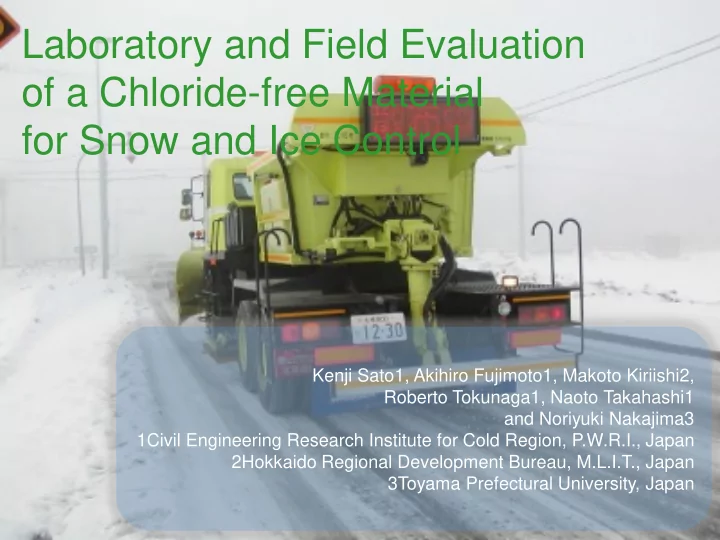

Laboratory and Field Evaluation of a Chloride-free Material for Snow and Ice Control Kenji Sato1, Akihiro Fujimoto1, Makoto Kiriishi2, Roberto Tokunaga1, Naoto Takahashi1 and Noriyuki Nakajima3 1Civil Engineering Research Institute for Cold Region, P.W.R.I., Japan 2Hokkaido Regional Development Bureau, M.L.I.T., Japan 3Toyama Prefectural University, Japan
Introduction Application of anti-icing and deicing agents and other measures for preventing wet roads from becoming icy are important for "ensuring safe and smooth winter road traffic". Sodium chloride (SC) is the major deicing agent Reasons why SC is applied: Inexpensive Easily available in large quantities Highly effective in melting ice Easy to deliver, store, and load onto vehicles Sodium chloride(SC)
Background and Aim of Study Although SC is the major deicing agent, There is a concern over negative impacts on the roadside environment caused by the application of chloride Vehicles Bridges and other roadside structures Soil, plants, etc. Development of a new chloride-free deicing agent that does not significantly damage the roadside environment Survey of various compounds in search for the best available deicer Tests focusing on Sodium propionate(SP) Laboratory metal corrosion test Application test at a test track
What is Sodium Propionate? General use: Used as a food preservative (i.e., fungicide) Food: Cheese, bread, cake Other products: Cosmetics, feed, paints, adhesives, etc. Retail price in Japan: US$10-15 / kg US$2 / kg for purchase of 10 tons at a time Form: Pulverized usually; Granulation possible Freezing point Specimen Freezing point (a 20%-by-mass solution) -19.1 ° C SC -16.1 ° C SP -18.9 ° C SC + SP (weight ratio 8:2)
State of SP Glanulated Powder Close up photo of 7mm an SP particle
Metal Corrosion Test Procedures Metal corrosion test by using various deicers 1) A 3.0 g of test material is dissolved in 100 cc of distilled water for preparing a test solution; 2) An iron specimen without zinc coating, which was weighed beforehand, was immersed in a solution of each test material for 24 hours and then left to dry for 24 hours; 3) The immersion-and-dry cycle was repeatedly conducted for 7 days; and 4) On the 8th day, the rust was completely removed from the specimen, and the remaining iron piece was weighed to see the difference in weight before versus after rusting.
Metal Corrosion Test Results Amount of corrosion Specimen (mg / dm 2 × day) Distilled water 8.6 mdd SC 22.5 mdd Calcium chloride (CC) 27.5 mdd SP 0.3 mdd SC + SP(weight ratio 8:2) 4.4 mdd In comparison to distilled water and the solution of SC or of CC, the amount of corrosion was significantly smaller for the SP solution and the SC+SP mixture with a weight ratio of 8:2. Metal corrosion damage to vehicles and roadside structures is reduced.
Test Method Test day January 21, 2015 Testing Location Tomakomai Winter Test Track(Length=2,700m) Civil Engineering Research Institute for Cold Region Public Works Research Institute Tomakomai Winter Test Track
Test Method January 21, 2015 Test day Weather Fine 18:41 ~ 22:47 Time -6.0 ~ -3.8 ° C Temp. -3.3 ~ -2.0 ° C Road Temp. Timing of Application after the track surface was frozen spreading No treatment NT SC Dry spreading SC SC + SP Dry spreading SC+SP (weight ratio 8:2) Test material SC+SP solution (30 %-by-mass solution) Wet spreading SC+SPS (weight ratio 9:1) SC+CC solution (30 %-by-mass solution) Wet spreading SC+CCS (weight ratio 9:1) 20 g/m2 Application rate Ice film on the road surface Five test vehicles Road temperature gauge t = 0.5 ~ 1.0mm 1. NT 2. SC 1 2 3 4 5 3. SC+SP 4. SC+SPS 100m 50m 50m 50m 50m 5. SC+CCS KP=0.35 KP=0.45 KP=0.55 KP=0.65 KP=0.75
Test Procedures Ice film on the road surface Five test vehicles Road temperature gauge t = 0.5 ~ 1.0mm 1. NT 2. SC 1 2 3 4 5 3. SC+SP 4. SC+SPS 50m 50m 50m 50m 5. SC+CCS KP=0.35 KP=0.45 KP=0.55 KP=0.65 KP=0.75 (1) (2) Salt application Sprinkling water for making ice film on the surface
Test Procedures Ice film on the road surface Five test vehicles Road temperature gauge t = 0.5 ~ 1.0mm 1. NT 2. SC 1 2 3 4 5 3. SC+SP 4. SC+SPS 50m 50m 50m 50m 5. SC+CCS KP=0.35 KP=0.45 KP=0.55 KP=0.65 KP=0.75 (3) (4) 5 test vehicles traveling in the test sections Skid resistance measurement
Continuous Friction Tester (CFT) 1-2 degrees Developed in the U.S. Movement Measures friction continuously direction Measurement wheel attached to a vehicle Measuring wheel offset 1-2 degrees Measures transverse force Lateral force Skid resistance expressed by “HFN” Measurement wheel (Tire) Skid resistance measurement principle HFN: Halliday Friction Number 0 (no load) 100 (dry pavement) CFT
Test Results 18:41 19:06 19:35 20:19 20:57 21:33 22:10 22:47
Summary and Future Study Results of the metal corrosion test SP helps reduce the amount of metal corrosion even when it is mixed with SC. Results of the application test Dry application of an SC+SP mixture as well as wet application of SC mixed with an SP solution is as effective as dry application of SC and wet application of SC mixed with a CC solution in increasing the skid resistance. Although SP is more expensive than SC, costs can be controlled by using a mixture of SP and SC. The research will be continued by focusing on the following topics with a view to increasing the use of SP as an deicer: Effectiveness of SP in melting ice Distribution and costs of SP Negative impacts caused by SP on soil, plant, and other aspects of the roadside environment
Thank you for your kind attention. Kenji Sato Traffic Engineering Research Team, Cold-Region Road Engineering Research Group Civil Engineering Research Institute for Cold Region, Public Works Research Institute, National Research and Development Agency satou-k22bi@ceri.go.jp
Recommend
More recommend